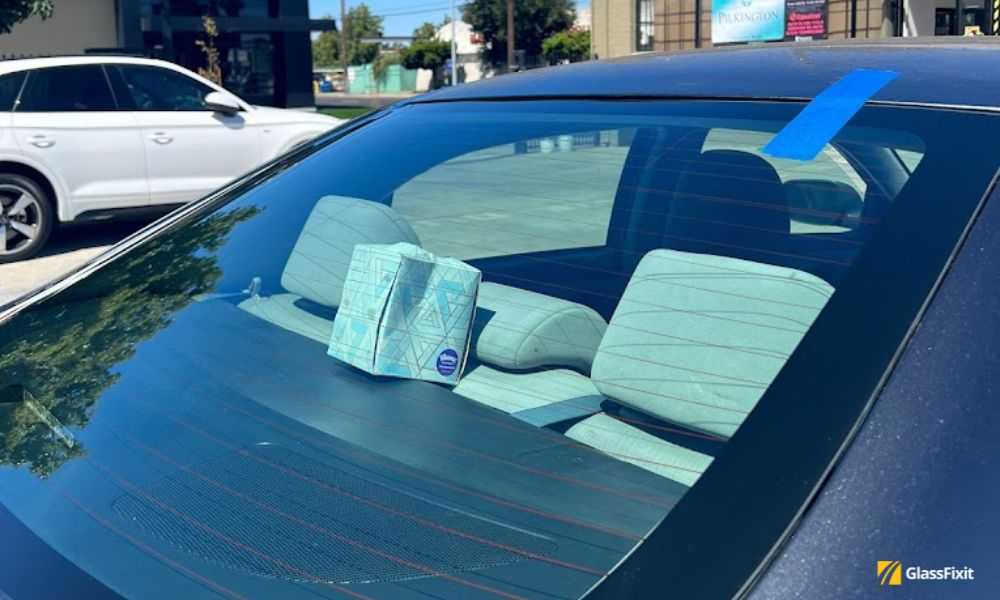Yes, many insurance policies do cover rear windshield replacement, but it depends on your specific coverage and the cause of the damage. Typically, if your rear windshield is shattered due to an accident or nature, your comprehensive insurance usually covers the repair or replacement costs. However, if the damage is from neglect or a collision that isn’t covered under your policy, you might have to pay out of pocket.
In short, whether your insurance will cover rear windshield replacement depends on your policy details and the circumstances of the damage. It’s always best to review your policy or contact your insurer to get clarity on your coverage options.
Cracked or broken rear windshields can be stressful and costly, but understanding your insurance coverage can save time and money. Many drivers are unsure if their policies include rear windshield repairs, leading to confusion and delays. Knowing whether your insurance covers such repairs can help you make quick, informed decisions and ensure you’re protected when needed most. This article explores the factors influencing coverage, common scenarios, and tips to handle rear windshield replacements smoothly.
Does Insurance Cover Rear Windshield Replacement?
Understanding Insurance Coverage for Windshield Repairs and Replacements
Many car owners wonder if their insurance will pay for replacing a rear windshield. The answer largely depends on your specific insurance policy and the type of damage. Generally, insurance plans cover glass repairs or replacements if the damage is caused by an accident or vandalism. However, coverage can vary, so it’s important to review your policy details.
Insurance companies often categorize glass coverage under comprehensive coverage. This type of insurance protects against damages that do not involve a collision, such as stone chips, vandalism, or severe weather. If you have comprehensive coverage, there’s a good chance that your insurer will cover the cost of replacing your rear windshield.
It’s essential to understand the difference between full coverage and limited coverage. Full coverage usually includes comprehensive insurance, making glass repairs more likely to be covered. Limited coverage might exclude glass damages, meaning you’ll need to pay out-of-pocket.
What Factors Influence Insurance Coverage for Rear Windshield Replacement?
Several factors determine whether your insurance will pay for replacing the rear windshield. The most significant ones include:
- Type of insurance policy: Whether you have comprehensive coverage or only liability coverage.
- Cause of damage: If the damage was caused by an accident, vandalism, or natural events like hail.
- Deductible amount: The sum you pay out-of-pocket before insurance covers the rest.
- Policy limits: The maximum amount your insurer will pay for a claim.
- State laws and regulations: Insurance rules vary by location, affecting coverage options.
Knowing these factors can help you predict whether your rear windshield replacement costs will be covered. Always check your policy or talk with your insurance agent for clarity.
Does Comprehensive Coverage Always Cover Rear Windshield Replacement?
While comprehensive coverage generally includes glass damage, it does not automatically guarantee full coverage. Some policies may have exclusions or specific conditions related to glass repairs. For example, some insurance providers might require you to use certain repair shops or get pre-authorization before repairs.
If you have this coverage, your insurer typically covers repairs with minimal or no deductible. However, if your deductible is high, you may still need to pay a significant amount out-of-pocket. Always review your policy for any limitations regarding windshield or rear windshield repairs.
Impact of Deductibles and Policy Limits on Coverage
Deductibles are the amount you pay before your insurer covers the remaining cost. For instance, if your deductible is $500 and your rear windshield replacement costs $800, you pay $500, and the insurer covers $300.
Policy limits refer to the maximum amount your insurance will pay for a claim. If your replacement exceeds this limit, you will need to pay the difference. It’s wise to understand your deductible and limit amounts beforehand to avoid surprises.
How to File a Claim for Rear Windshield Replacement
Filing a claim is straightforward but requires following specific steps:
- Contact your insurance provider promptly after noticing the damage.
- Provide detailed information about the damage and circumstances.
- Arrange for an inspection or appraisal if needed.
- Choose an approved repair shop, if your insurer requires it.
- Schedule the repair and ensure all documents are in order for reimbursement.
Make sure to keep receipts and photos of the damage, as these can support your claim.
Factors That Might Prevent Insurance Coverage
Certain situations can limit or eliminate coverage for rear windshield replacement:
- Using a non-approved repair shop
- Neglecting to report damage promptly
- Damage caused intentionally or through reckless driving
- Damage occurring outside your covered events (e.g., vandalism when only collision is covered)
- Policy exclusions, such as damages from wear and tear or manufacturing defects
Understanding your policy’s exclusions helps prevent surprises when filing a claim.
Alternatives to Insurance Coverage for Rear Windshield Replacement
If your insurance does not cover rear windshield replacement, you might consider the following options:
- Paying out-of-pocket for repairs, which can be cheaper if your deductible is high.
- Using aftermarket or used windshields to reduce costs.
- Seeking local repair shops that offer discounts or financing plans.
- Checking if your warranty or manufacturer coverage includes glass repairs.
Comparing these options can save you money and time.
Cost of Rear Windshield Replacement Without Insurance
The cost of replacing a rear windshield varies depending on the vehicle model and the type of glass. Typically, prices range from $200 to over $600.
Labor costs also play a role, with professional installation usually costing between $100 and $300. Specialty or luxury vehicles can even cost more. Always request quotes from multiple repair shops to find the best deal.
Factors Influencing Replacement Costs
Numerous factors affect how much you’ll pay for rear windshield replacement, including:
- Type of vehicle: More complex or luxury cars often have higher costs.
- Type of glass: OEM (original equipment manufacturer) glass tends to be more expensive than aftermarket options.
- Extent of damage: Larger chips or cracks may require full replacement rather than repair.
- Additional repairs: Some situations require frame adjustments or additional parts, increasing costs.
Understanding these factors ensures you plan financially for your repair.
Choosing the Right Repair Shop
Selecting a reputable repair shop is critical for quality service and durability. Certified shops often use high-quality materials and skilled technicians. Verify if the shop works with your insurance provider to streamline billing.
Read reviews and ask for warranties on repairs to ensure a long-lasting fix. A proper installation prevents future issues like leaks or glass shattering.
Related Topics and Tips for Car Owners
Car owners should also consider:
Maintaining Your Windshield
Regular cleaning and prompt repair of chips or cracks can prevent larger damages. Use glass protectants to reduce the risk of cracks spreading.
Understanding Your Insurance Policy
Review your coverage annually to stay informed about what is included and what is not. Clarify deductibles, limits, and approved repair shops.
When to Report Damage
Report any damage as soon as possible to facilitate insurance claims and prevent further deterioration. Early repairs often cost less and are easier to process.
Conclusion
Knowing whether your insurance covers rear windshield replacement helps you make informed decisions after damage occurs. Understand your policy details, coverage limits, and deductibles to avoid surprises. When you’re prepared and knowledgeable, fixing your rear windshield becomes much easier and less stressful.
Windshield Repair/Replacement Cost & Your Insurance | Safelite AutoGlass
Frequently Asked Questions
Does comprehensive auto insurance usually cover rear windshield replacements?
Yes, comprehensive auto insurance often covers the replacement of a rear windshield if it gets damaged due to incidents like vandalism, falling objects, or weather-related events. However, it’s essential to review your specific policy, as coverage limits and deductibles can vary between providers.
Are there situations where insurance might deny coverage for rear windshield repairs?
Insurance companies might deny coverage if the damage results from neglect or an accident not covered under your policy, such as intentional damage or driving under the influence. Additionally, if you do not have comprehensive coverage, insurance may not cover the repair at all.
Does filing a claim for rear windshield replacement affect my insurance premiums?
Filing a claim for a rear windshield replacement can impact your premiums, especially if you file multiple claims within a short period. Some providers might increase your rates or consider you a higher risk after a claim; others may not see it significantly affecting your costs.
Will my insurance cover the entire cost of rear windshield replacement?
Coverage depends on your policy’s terms, deductibles, and the damage’s cause. Typically, if the damage is covered, your insurance will pay for the repair minus your deductible. It’s advisable to verify your policy’s specifics to understand your out-of-pocket expenses.
What steps should I take before filing an insurance claim for a damaged rear windshield?
First, assess the damage and document it with photos. Contact your insurance provider to understand the claim process and confirm coverage. Obtain repair estimates from trusted auto glass repair shops, and follow their instructions for filing the claim to ensure a smooth process.
Final Thoughts
Insurance coverage for rear windshield replacement varies depending on your policy. Many plans include glass coverage, but some may require a deductible.
Checking your specific policy details helps you understand what is covered and any out-of-pocket costs.
In most cases, insurance does cover rear windshield replacement if it results from an accident or vandalism.
Overall, the answer to “does insurance cover rear windshield replacement” is often yes, but reviewing your policy ensures you know your precise coverage.



